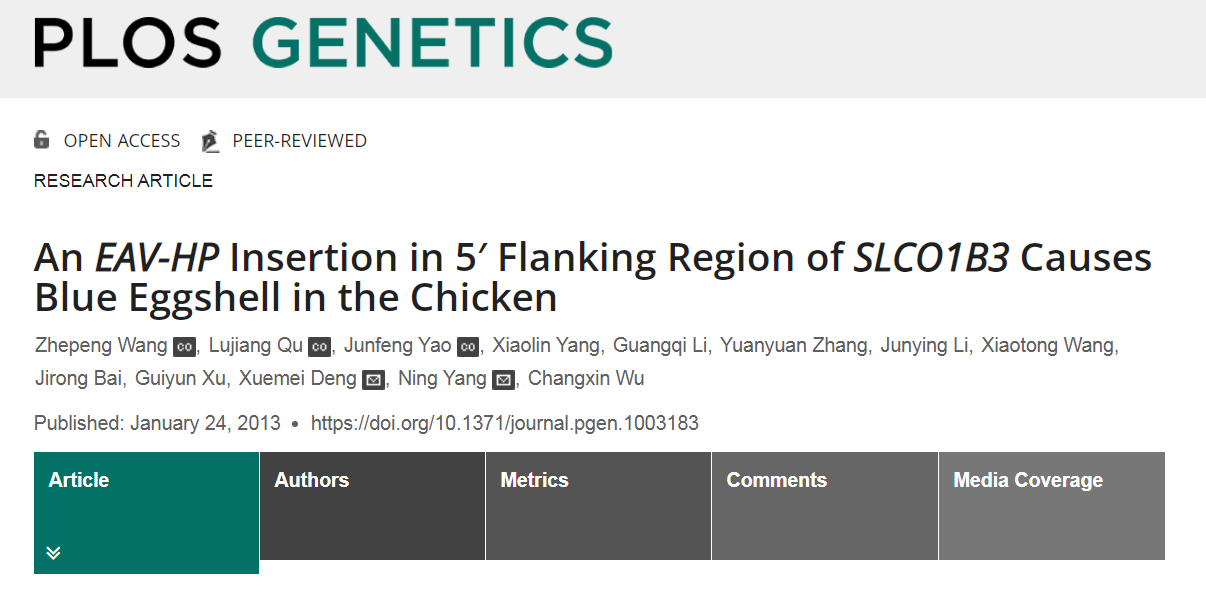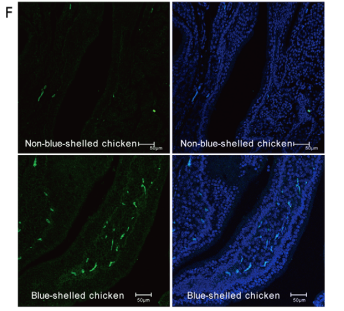research target:eggshell
Periodicals:PLOS GENETICS;
IF:8.517
Cooperative Unit:Ludong University
Time of publication:January,2013.

Summary
The genetic determination of eggshell coloration has not been determined in birds. Here we report that the blue eggshell is caused by an EAV-HP insertion that promotes the expression of SLCO1B3 gene in the uterus (shell gland) of the oviduct in chicken. In this study, the genetic map location of the blue eggshell gene was refined by linkage analysis in an F2 chicken population, and four candidate genes within the refined interval were subsequently tested for their expression levels in the shell gland of the uterus from blue-shelled and non-blue-shelled hens. SLCO1B3 gene was found to be the only one expressed in the uterus of blue-shelled hens but not in that of non-blue-shelled hens. Results from a pyrosequencing analysis showed that only the allele of SLCO1B3 from blue-shelled chickens was expressed in the uterus of heterozygous hens (O*LC/O*N). SLCO1B3 gene belongs to the organic anion transporting polypeptide (OATP) family; and the OATPs, functioning as membrane transporters, have been reported for the transportation of amphipathic organic compounds, including bile salt in mammals. We subsequently resequenced the whole genomic region of SLCO1B3 and discovered an EAV-HP insertion in the 59 flanking region of SLCO1B3. The EAV-HP insertion was found closely associated with blue eggshell phenotype following complete Mendelian segregation. In situ hybridization also demonstrated that the blue eggshell is associated with ectopic expression of SLCO1B3 in shell glands of uterus. Our finding strongly suggests that the EAV-HP insertion is the causative mutation for the blue eggshell phenotype. The insertion was also found in another Chinese blueshelled breed and an American blue-shelled breed. In addition, we found that the insertion site in the blue-shelled chickens from Araucana is different from that in Chinese breeds, which implied independent integration events in the blue-shelled chickens from the two continents, providing a parallel evolutionary example at the molecular level.
Keywords:EAV-HP insertion,SLCO1B3 gene,Pyrosequencing,blue eggshell dominance
Research Background
Brown and white are the two major eggshell colors in chickens. Protoporphyrin-IX, biliverdin, and biliverdin zinc chelate are the main pigments of the eggshell and several blue egg laying breeds have been reported worldwide.The Araucana, an indigenous breed from Chile, was the first chicken breed described to lay blue eggs , and has been frequently used in genetic studies of the blue eggshell phenotype. In China, Dongxiang and Lushi chickens are representative breeds laying blue eggs and show dominant inheritance as that in Araucana. However, the blue eggshell phenotype has not been fixed in these three breeds which still produce brown eggs at low frequency.
Blue eggshell color exhibits an autosomal dominant inheritance and eggs laid by homozygotes are a darker blue than those from heterozygotes . In 1933, Punnett firstly reported that blue or green shell appearance of the Araucana was determined by a single genetic factor, traditionally denoted as oocyan (O) . A series of linkage analysis involving O have been performed with O affirmatively mapped to the short arm of chromosome 1 , and closely linked to ev1 and P which was identified as SRY (sex determining region Y)-box 5 (SOX5) . In the region around ev1, two single nucleotide polymorphisms (SNPs) (rs15297163 and rs15297165) were found to be highly associated with the blue eggshell phenotype.
Partial results of cooperation
 BersinbioTM cooperative technology:FISH
Original link:http://europepmc.org/articles/PMC3554524
BersinbioTM cooperative technology:FISH
Original link:http://europepmc.org/articles/PMC3554524
